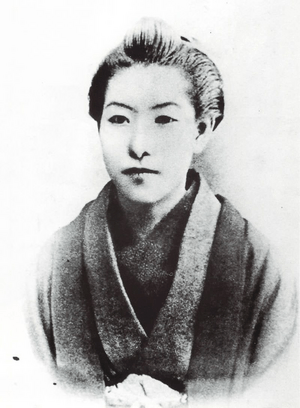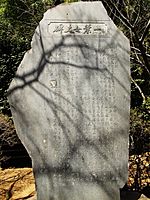Ichiyō Higuchi facts for kids
Quick facts for kids
Ichiyō Higuchi
|
|
|---|---|
 |
|
| Native name |
樋口 一葉
|
| Born | Natsuko Higuchi May 2, 1872 Uchisaiwaichō, Tokyo, Japan |
| Died | November 23, 1896 (aged 24) Tokyo, Japan |
| Resting place | Yanaka Cemetery, Tokyo, Japan |
| Pen name | Ichiyō Higuchi |
| Occupation | writer |
| Nationality | Japanese |
| Period | Meiji |
| Genre | fiction |
Natsu Higuchi (樋口 奈津, Higuchi Natsu, May 2, 1872 – November 23, 1896), known by her pen name Ichiyō Higuchi (樋口 一葉, Higuchi Ichiyō), also known as Natsuko Higuchi (樋口 夏子, Higuchi Natsuko), was a Japanese writer from the Meiji Period. Higuchi was unique among her peers in that her writing was based on Japanese rather than Western models. Born into a minor samurai family, her experience of poverty (particularly after the death of her father in 1889, at which point she took on the responsibility as head of an all-female household) informed her writing, which included themes of abandonment and suffering combined with sensitivity. Specializing in short stories, she was one of the first important writers to appear in the Meiji period (1868–1912) and Japan's first prominent woman writer of modern times. She was also an extensive diarist. She wrote relatively little as a result of living a brief life — she died at 24 — but her stories have had a large impact on Japanese literature.
Early life
Natsuko Higuchi was born in Chiyoda-ku, Tokyo, on May 2, 1872, the youngest daughter of Noriyoshi Higuchi, a samurai from the nearby Yamanashi Prefecture. Her parents were from a peasant community but her father had managed to procure samurai status in 1867. Despite only enjoying the position for a short time before the samurai were abolished with the Meiji Restoration, growing up in a samurai household was a formative experience for her.
In 1886, she began studying waka poetry at one of the best of the poetic conservatories, the Haginoya, and became a student of Nakajima Utako. Here she received weekly poetry lessons and lectures on Japanese literature. There were also monthly poetry competitions in which all students, past and present, were invited to participate. Poetry taught at this school was that of the conservative court poets of the Heian period. She always felt awkward among the other students, the great majority of whom came from the upper-class. It did not help that she was nearsighted, modest, small, and with thin hair.
Her compulsion to write became evident by 1891 when she began to keep a diary in earnest. It would become hundreds of pages long, covering the five years left in her life. With her feelings of social inferiority, her timidity, and the increasing poverty of her family, her diary was the place where she could assert herself. Her journals were also a place for her to assert objectivity and included her views on literary art and well as others' views on her work.
Efforts to become a writer
In 1889, her father died and she was named as head of the family, an unusual position at the time. Finances were very tight and she, her mother, and younger sister made ends meet by doing needlework, washing, and other jobs. In 1892, after seeing the success of a classmate, Kaho Tanabe, who wrote a novel, Higuchi decided to become a novelist to support her family.
Her initial efforts at writing fiction were in the form of a short story. In 1891 she met her future advisor who would help, she assumed, this poet-turned-fiction-writer and connect her with editors: Tosui Nakarai. She fell in love with him right away. Her mentor did not return her passionate, if discreet, love for him, and instead treated her as a younger sister. This failed relationship would become a recurrent theme in Higuchi's fiction.
Eventually, she got the break she was so eager for: her first stories were published in a minor newspaper under her pen name, Ichiyo Higuchi. The stories from this first period (1892–1894) suffered from the excessive influence of Heian poetry. Higuchi felt compelled to demonstrate her classical literary training. The plots were thin, there was little development of character and they were loaded down by excessive sentiment, especially when compared to what she was writing concurrently in her diary. But she was developing rapidly. Several of her trademark themes appear; for example, the triangular relationship among a lonely, beautiful, young woman who has lost her parents, a handsome man who has abandoned her (and remains in the background), and a lonely and desperate ragamuffin who falls in love with her. Another theme Higuchi repeated was the ambition and cruelty of the Meiji middle class.
The story "Umoregi" ("In Obscurity") signaled Higuchi's arrival as a professional writer. It was published in the prestigious journal Miyako no Hana in 1892, only nine months after she had started writing in earnest. Her work was noticed and she was recognized as a promising new author.
Last years
In 1893, Higuchi, her mother and her sister abandoned their middle-class house and, with a grim determination to survive, moved to a poor neighborhood where they opened a stationery store that before long failed. Her experience living in this neighborhood would provide material for several of her later stories, especially "Takekurabe", (literally, "Comparing heights"; "Child's Play" in the Robert Lyons Danly translation; also called "Growing Up" in the Edward Seidensticker translation).
The stories of her mature period (1894–1896) were influenced by Ihara Saikaku, a 17th-century writer, whose stories she had recently discovered. His distinctiveness lay in great part in his acceptance of low-life characters as worthwhile literary subjects. What Higuchi added was a special awareness of suffering and sensitivity. To this period belong "Ōtsugomori" ("On the Last Day of the Year"), "Nigorie" ("Troubled Waters"), "Wakare-Michi" ("Separate Ways"), "Jūsan'ya" ("The Thirteenth Night") and "Takekurabe" ("Child's Play"). The last two are considered her best work.
With these last stories, her fame spread throughout the Tokyo literary establishment. She was commended for her traditional style, and was called "the last woman of the old Meiji" in reflection of her evocation of the past.{ In her modest home, she was visited by other writers, students of poetry, admirers, the curious, critics, and editors requesting her collaboration. Due to constant interruptions and frequent headaches, Higuchi stopped writing. As her father and one of her brothers had before her, she contracted tuberculosis. She died on November 23, 1896. She was 24.
Higuchi's likeness adorns the Japanese 5000 yen banknote as of fall 2004, becoming the third woman to appear on a Japanese banknote, after Empress Jingū in 1881 and Murasaki Shikibu in 2000. Her best-known stories have been made into movies. She was buried in Tsukiji Hongan-ji Wadabori Cemetery in Suginami, Tokyo.
Selected works
The year refers to the date of first publication.
- 1892: Yamizakura (闇桜, Flowers at Dusk)
- 1892: Wakarejimo (別れ霜)
- 1892: Tamadasuki (玉襷)
- 1892: Samidare (五月雨)
- 1892: Kyōtsukue (経づくえ)
- 1892: Umoregi (うもれ木)
- 1893: Aketsukiyo (暁月夜)
- 1893: Yuki no hi (雪の日, A Snowy Day)
- 1893: Koto no ne (琴の音, The Sound of the Koto)
- 1894: Hanagomorie (花ごもり)
- 1894: Yamiyo (やみ夜, Encounters on a Dark Night)
- 1894: Ōtsugomori (大つごもり, On the Last Day of the Year or The Last Day of the Year)
- 1895: Takekurabe (たけくらべ, Child's Play, Growing Up, They Compare Heights or Teenagers Vying for Tops)
- 1895: Noki moru tsuki (軒もる月)
- 1895: Yukugumo (ゆく雲)
- 1895: Utsusemi (うつせみ)
- 1895: Nigorie (にごりえ, Troubled Waters, Muddy Water or In the Gutter)
- 1895: Jūsan'ya (十三夜, The Thirteenth Night)
- 1896: Kono ko (この子)
- 1896: Wakare-michi (わかれ道, Separate Ways or The Parting of the Ways)
- 1896: Ware-kara (われから)
See also
 In Spanish: Ichiyō Higuchi para niños
In Spanish: Ichiyō Higuchi para niños



